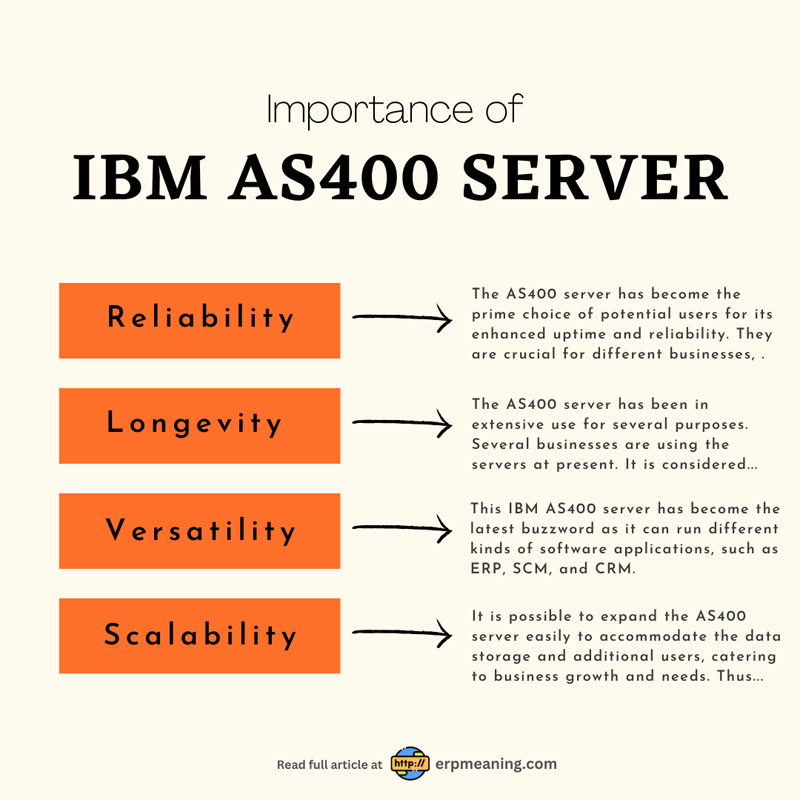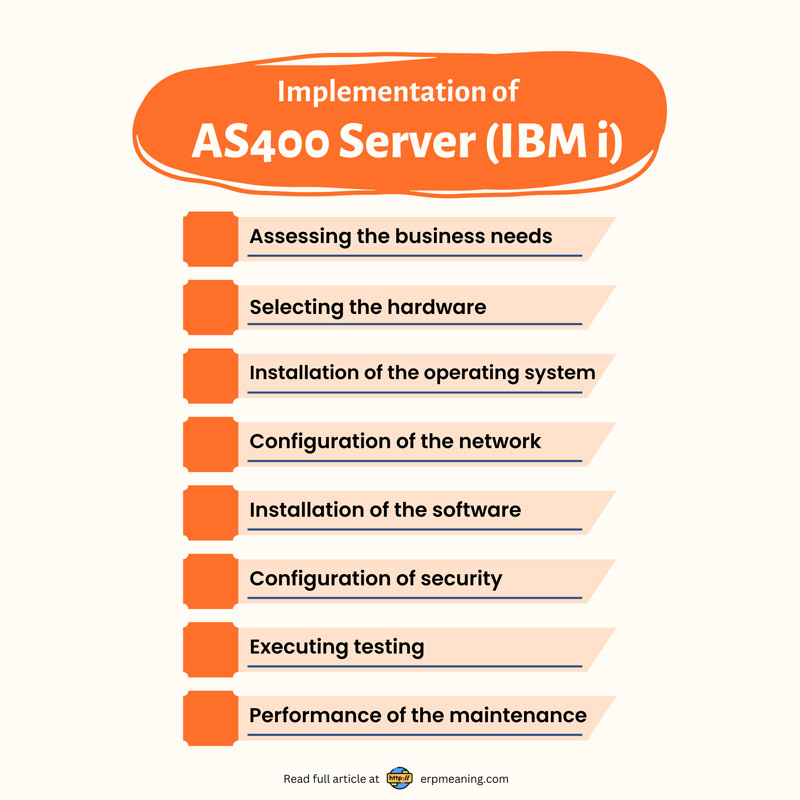
AS400 Server has gained a high reputation as the IBM system or IBM Series Server. It is regarded as a kind of server, created by IBM in the latter part of the 1980s by IBM. It refers to the midrange server, which is meant to achieve different kinds of business objectives. People prefer to use AS400 servers for their scalability, security, and reliability.
IBM Iseries server has the ability to run different kinds of operating systems. A wide assortment of people prefers to use the server to accomplish different kinds of objectives, such as CRM, SCM, ERP, and database management. It happens to be the best option for businesses, which need a server to handle massive data volumes.
AS400 server is also known as the IBM AS400 server. It boasts a proprietary operating system, which has become an extensive choice for its stability and user-friendliness. Moreover, it can run different kinds of operating systems, like AIX, Windows, and Linux.
Several servers are used in different industries, like banking, healthcare, and manufacturing, where reliability and data security are essential. It has become the number one choice of people for disaster recovery capabilities and enhanced availability. It assures that the business can continue to operate in case of system failure and different kinds of catastrophic events.
How do AS400 Servers work?
The AS400 servers works through the processing of data, followed by the running of different software apps that get installed on the server. Now, we are going to give an overview of the working principles of AS 400 servers:
Data Storage
The AS 400 server helps save the data on different kinds of external storage devices and internal hard drives. Such kinds of data get organized within the libraries. They have similarities to the folders on the computer. Every library comprises either the files, which are accessed by the software apps that are installed on the server or the databases.
Different software apps
The software applications get installed on the AS400 server. They are meant to execute different kinds of tasks, like supply chain management, customer relationship management, and enterprise resource planning. Such apps get installed on the operating system of the server, which refers to IBM I.
Processing the data
The AS400 servers executes the programs and commands that are submitted by the software apps and users, thereby processing the data. This IBM AS 400 server adopts the programming language, which is regarded as the Report Program Generator, or RPG. It lends a helping hand in the processing of the data.
Input/Output
The AS400 server is known to communicate with potential users and devices via I/O and input and output operations. The input operations provide the best choice to the potential users for submitting the data within the system. The output operations, on the other hand, enable the AS400 servers to offer data to potential users and different devices.
Security
The AS 400 servers are meant to be extremely secure, with different kinds of features like authentication, seeking access to the control, and encryption. Access to the data and different software apps is limited, depending on the roles and user permissions. Thus, the AS400 servers make the proper use of encryption to save the data at rest and during the transition.
Maintenance
The AS400 server needs regular maintenance for enhanced reliability and optimal performance. Different kinds of maintenance tasks are hardware upgrades, software updates, disaster recovery processes, and backups.
Read also: What is As400 (IBM AS/400)? Is AS 400 System still used in 2023?

Why AS400 Server is Important?
The AS400 server has received immense popularity as the IBM system, or AS400 iSeries. It has become the prime choice of people for several reasons, which are listed below:
Security.
People prefer to opt for the IBM AS400 server owing to different kinds of robust security features, like encryption, authentication, and access control. IBM iseries servers are known to be highly secure. They provide a prerequisite for protecting crucial data from various cyberattacks and unauthorized access.
Reliability
The AS400 server has become the prime choice of potential users for its enhanced uptime and reliability. They are crucial for different businesses, which depend on the servers for different critical operations. IBM iseries servers are designated with different redundant components, like storage, power supplies, and network connections. They assure that the IBM AS400 server has the ability to operate in the case of hardware failures.
Longevity
The AS400 server has been in extensive use for several purposes. Several businesses are using the servers at present. It is considered to be a testament to its reliability and durability. Different businesses are depending on the IBM AS 400 server, as they are investing heavily in the platform. They are creating different kinds of systems and applications that are hard to move to other kinds of platforms.
Versatility
This IBM AS400 server has become the latest buzzword as it can run different kinds of software applications, such as enterprise resource planning, database management, supply chain management, and customer relationship management. Hence, they contribute to becoming the number one choice for different businesses, which want the IBM iseries server to handle different kinds of tasks.
Scalability
It is possible to expand the AS400 server easily to accommodate the data storage and additional users, catering to business growth and needs. Thus, it is considered to be the top option for different businesses, with unpredictable data that processes the needs.

Implementation of the AS400 Server
The implementation of the AS400 server involves different kinds of steps, which vary according to the business’s needs. Now, we are going to tell about the various steps that are included in the implementation of the AS 400 servers:
Assessing the business needs
The primary step in the implementation of the AS400 server is seeking access to the business requirements. It involves the determination of the workload, the data storage needs, the total count of potential users, and the different kinds of software or apps that should be installed.
Selecting the hardware
The next step involves selecting the hardware, which is used for the AS 400 server. It involves choosing the proper model of the IBM AS400 server, and the extra components. like network adapters, memory, and disk drives.
Installation of the operating system
After choosing the hardware, the next step involves the installation of the As400 operating system on the server. It includes the incorporation of the installation media and following different prompts for the installation of the operating system.
Configuration of the network
Once the installation of the operating system is complete, the next step involves the configuration of different network settings. It includes setting the subnet mask, IP address, and default gateway.
Installation of the software
After the configuration of the network, the next step involves the installation of the necessary applications or software on the IBM AS400 server. Moreover, it includes enterprise resource planning software, a database management system, and different kinds of custom apps.
Configuration of security
In this phase, it is possible to configure different security settings on the AS400 server. It includes the creation of user accounts, the configuration of access control, and enabling of encryption.
Executing testing
After setting up and configuring the AS400 server, the next step involves the execution of the testing. It assures that the server is functioning properly. It involves the testing of the data storage, network connectivity, and different installed applications.
Performance of the maintenance
As the AS400 server is running, it is essential to perform regular maintenance to ensure smooth operation. It includes monitoring performance, the performance of the software update, and backing up the data.
Integration of the AS 400 Server
Integration of the IBM AS400 server with different apps and systems helps businesses streamline different kinds of operations. It plays an integral role in decreasing errors and improving efficiency. Now, we are going to tell you about the steps that are involved in the integration of the IBM AS400 server with different applications and systems:
Identification of the integration needs
The initial step in the integration of the AS400 server with different applications and systems is recognizing the integration needs. It involves finding the applications and systems that should be integrated, along with the kind of data that should be exchanged and the data exchange frequency.
Opting for the integration process
The next step involves selecting the integration method that needs to be used. It includes the use of mid-ware tools like web services, IBM MQ, and APIs.
Creation of the integration plan
After selecting the integration process, the next step involves creating the integration plan. It involves the creation of a detailed plan for how the applications and systems are integrated and the documentation of different kinds of data exchange processes.
The implementation of the integration
After the creation of the integration plan, the next phase is the implementation of the integration. It includes the creation of customized integration code, the configuration of different middleware tools, and the configuration of APIs and web services.
Testing and monitoring
In this step, the IBM AS400 server is tested, thereby ensuring that they are functioning properly. It involves the handling of errors, the processing of the exchanged data, and performance. After the completion of the testing process, the next step is monitoring, thereby ensuring that it is running properly. It includes error logs, monitoring the performance, and data exchange processes.
Maintenance and performance
It is essential to execute regular maintenance on the integration, thereby ensuring that it is running smoothly. It is inclusive of the monitoring of performance, performance of the software updates, introduction of the modifications, and prerequisite changes.
Features of AS400 Server
Now, we are going to tell you about the different features of the AS400 server:
Operating system
AS 400 server is executed on the IBM I operating system. It is meant to handle different kinds of workloads virtually. Thus, it is considered the primary option for businesses needing the server platform to handle different tasks.
Virtualization
This AS400 Server provides support for virtualization. Thus, it enables the execution of different operating systems on a single physical server. Thus, it is useful to businesses in saving money on different hardware costs.
Database management
Such AS400 Server is inclusive of the ready-made relational data management system, referred to as DB2 or AS400 database. Thus, it is considered to be the proper option for businesses that need a massive database management system that can manage massive data volumes.
Security
Such an AS400 Server is meant for different kinds of robust security features, like encryption, authentication, and access control. Such features help secure sensitive and crucial data from cyberattacks and unauthorized access.
Enhanced Availability
This specific server is meant for high availability with redundant components, like storage, power supplies, and network connections. Thus, it ensures that the server can operate during hard drive failures.
Recovery and Backup
This AS400 Server involves a bunch of features, such as disaster recovery and automated backups. It assures the protection of critical data. Thus, you can restore it faster during system failures.
Application development
This AS400 Server is inclusive of a variety of development tools. Moreover, it also involves different languages, like Java, COBOL, and RPG. Thus it is useful for businesses to create customized applications, which are meant to certain needs.
Model of AS400 Server
Model 800 for the small businesses
People running startups and small businesses with different kinds of IT resources should make sure to opt for a budget-friendly and easy-to-run server. It provides the prerequisite support and solutions.
The Model 800 is the most affordable server, along with solutions that are meant for small businesses. It is possible to manage the model on a Windows-based computer. It helps train the operators easily and faster. The majority of the startups can at least run a Windows server. This IBM iseries server is capable of integrating Intel-based servers. Thus, you will be able to handle the system effectively.
Model 810 for mid-scale and small-scale businesses
This model is considered to be the best option for small and medium-sized businesses. Thus, you can stay away from the management costs and complications involved in running the server firm. The solutions for the industry are meant for different kinds of e-business applications.
Models for large-scale and mid-scale businesses
This model stands out from the ordinary in offering outstanding performance. Such technology is available on a plethora of enterprise-class IBM I Series servers. Such features boast capacity on demand. Thus, you can get the prerequisite performance. The server consolidations tools help combine several workloads on a single server. It allows the consolidation of the Linux applications up to 31 partitions with the LPA. Thus, you can manage the Windows Server with the integrated xSeries adapter.
Conclusion
To sum it up, the AS400 server happens to be a secure and reliable midrange server that can run a variety of software applications. Thus, it has become the number one choice of potential users for its disaster recovery capabilities, higher availability, and scalability. Such kinds of features make it the number one option for different businesses, which need a flexible and reliable server, thereby supporting the operations.
Read also
- What is AS400 Mainframe? Example of AS/400 Mainframe
- What is AS400 ERP Software? AS400 Accounting Software
- Os400 vs As400: What’s the Difference?
